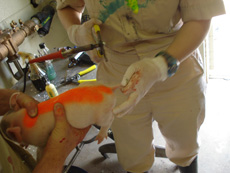The Tail Biting and Tail Docking Site
Overview
Pigs typically have their tails docked to prevent tail biting behaviors. Even pigs that have their tails docked show some tail biting. When the tails are left intact, the chance of tail biting is very high. In our studies we left tails intact and the pigs began a severe case of tail biting (McGlone et al., 1990; Sutherland et al., 2009). Thus, tail docking is a standard procedure, usually performed in the first few days of life. Clearly, pig welfare is much better when pigs experience the negative effect of tail docking than if the tails were left intact and the pigs experienced almost certain tail biting.
Our laboratory has been studying tail biting in pigs for over 20 years. Two main areas have been investigated. In the first, we seek to understand and reduce the stress associated with tail docking in piglets. Second, we wish to find ways to reduce the tail biting experience among finishing pigs (~100-250 lb when the behavior most often erupts).
At the moment, there are few viable alternatives to tail docking. We do know that by using a hot cautery cutter instead of a cold cutter, we can reduce the stress experience of tail docking (Sutherland et al., 2009). General anesthetics like CO2 will reduce the immediate pain-related behaviors during tail docking (Sutherland et al., 20011). Local anesthetics are not particularly effective at mitigating the pain-related behaviors after tail docking possibly because they are too short-acting (Sutherland et al., 2009).
We understand that crowding pigs does not make the tail biting risk any different than among pigs that are not crowded (McGlone and Nicholson, 1992). And we know that we can stop or slow the rate of tail biting in finishing pigs by use of straw or earth as a form of enrichment (McGlone et al., 1992).
Scientific Publications
- McGlone, J. J., J. S. Sells, S. Harris and R. J. Hurst. 1990. Cannibalism in growing pigs: effects of tail docking and housing system on behavior, performance and immune function. Texas Tech University Animal Science Research Report.
- McGlone, J. J. and R. I. Nicholson. 1992. Effects of limited floor and feeder space on pig performance and tail biting. Texas Tech University Animal Science Research Report.
- McGlone, J. J., W. Vermette and G. Larson. 1992. Field investigations of tail biting episodes on a pork production unit. ='Texas Tech University Animal Science Research Report.
- Kleinbeck, S. and J. J. McGlone. 1993. Pig tail posture: A measure of stress. Texas Tech University Animal Science Research Report.
- Sutherland MA, Bryer PJ, Krebs N, McGlone JJ. 2008. Tail docking in pigs: acute physiological and behavioral responses. Animal. 2(2):292-297.
- Sutherland, M. A., P. J. Bryer, N. Krebs, and J. J. McGlone. 2009. The effects of method of tail docking on tail-biting behavior and welfare of pigs. Animal Welfare. 18:561-570.
- Sutherland, M. A., B. L. Davis, and J. J. McGlone. 2011. The effect of local or general anesthesia on the physiology and behavior of tail docked pigs. Animal. 5:1237-1246.

Laboratory of Animal Behavior, Physiology and Welfare
-
Address
1308 Indiana Ave Lubbock, TX 79409-2141 -
Phone
806.834.8275 -
Email
john.mcglone@ttu.edu
